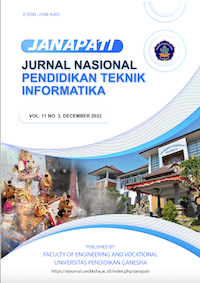Identifikasi Sebaran Nitrogen pada Tanaman Padi berbasis Pengetahuan Fenologi dan Remote Sensing
DOI:
https://doi.org/10.23887/janapati.v11i3.50051Keywords:
GEE, Harmonic Model, NDRE, Nitrogen, Phenology, SatelliteAbstract
Nitrogen sangat penting untuk keberlanjutan tanaman padi. Kebutuhan nitrogen pada tanaman padi berguna untuk produktivitas dan peningkatan hasil panen. Masalah yang sering terjadi, kekurangan dan berlebihan nitrogen, juga tidak cocok untuk tanaman, terutama pada puncak fenologi tanaman padi. Oleh karena itu, penelitian ini bertujuan untuk identifikasi sebaran nitrogen pada tanaman padi pada puncak fenologi tanaman. Identifikasi nitrogen dilakukan dengan data citra satelit dan indikator indeks spectral seperti NDVI, NDRE, NDMI, dan data curah hujan. Selain itu, pemodelan tren musiman dibangun dengan regresi linier dan model harmonik sebagai basis pengetahuan untuk pola penanaman padi dari fenologi tanaman. Hasil yang diperoleh menunjukkan puncak penanaman padi dalam satu tahun masa tanam, terdapat dua siklus puncak; (1) dari bulan Januari hingga Maret; (2) dari bulan Juli hingga Agustus. Kemudian pada siklus puncak penanaman kedua, konservasi terhadap identifikasi sebaran nitrogen dalam kondisi normal. Sementara itu, pada siklus penanaman puncak pertama, tanaman padi pada bulan Januari ketersediaan sebaran nitrogen belum merata dan belum tercukupi.
References
Kementerian Pertanian, “Statistik perkebunan Indonesia 2018-2020,” Buku Stat. Perkeb. Indones., pp. 1–82, 2020.
S. Juliati, “Penentuan Indeks Kebutuhan Hara Makro Pada Tanaman Mangga Dengan Metode Diagnosis and Recommendation Integrated System,” J. Hortik., vol. 20, no. 2, p. 83977, 2010, doi: 10.21082/jhort.v20n2.2010.p.
M. E. Martin and J. D. Aber, “High Spectral Resolution Remote Sensing of Forest Canopy Lignin, Nitrogen, and Ecosystem Processes.” 1997.
K. Arai, “Rice Crop Quality Evaluation Method through Regressive Analysis between Nitrogen Content and Near Infrared Reflectance of Rice Leaves Measured from Near Field,” Int. J. Adv. Res. Artif. Intell., vol. 2, no. 5, pp. 1–6, 2013, doi: 10.14569/ijarai.2013.020501.
S. D. Afandi, “Estimasi kadar nitrogen tanaman padi menggunakan spectral reflectance,” Tesis, 2016.
J. D. Colorado et al., “Estimation of nitrogen in rice crops from UAV-captured images,” Remote Sens., vol. 12, no. 20, pp. 1–31, 2020, doi: 10.3390/rs12203396.
X. Du et al., “Multi-temporal monitoring of leaf area index of rice under different nitrogen treatments using UAV images,” Int. J. Precis. Agric. Aviat., vol. 1, no. 1, pp. 7–12, 2018, doi: 10.33440/j.ijpaa.20200301.57.
L. Wang et al., “Estimation of paddy rice nitrogen content and accumulation both at leaf and plant levels from uav hyperspectral imagery,” Remote Sens., vol. 13, no. 15, pp. 1–21, 2021, doi: 10.3390/rs13152956.
N. Horning, “Land cover classification methods, Version 1.0,” J. Plant Ecol., vol. 3, no. 1, p. 863, 2013, doi: 10.1017/CBO9781107415324.004.
J. W. Rouse, R. H. Haas, J. A. Schell, and D. W. Deering, “Monitoring the vernal advancement and retrogradation (green wave effect) of natural vegetation,” Prog. Rep. RSC 1978-1, p. 112, 1973.
J. A. Gamon et al., “NDVI canopy structure photosynthesis,” vol. 5, no. 1, pp. 28–41, 1995.
M. Boschetti, D. Stroppiana, P. A. Brivio, and S. Bocchi, “Multi-year monitoring of rice crop phenology through time series analysis of MODIS images,” Int. J. Remote Sens., vol. 30, no. 18, pp. 4643–4662, 2009, doi: 10.1080/01431160802632249.
T. Sakamoto, M. Yokozawa, H. Toritani, M. Shibayama, N. Ishitsuka, and H. Ohno, “A crop phenology detection method using time-series MODIS data,” Remote Sens. Environ., vol. 96, no. 3–4, pp. 366–374, 2005, doi: 10.1016/j.rse.2005.03.008.
S. Ibrahim, J. Kaduk, K. Tansey, H. Balzter, and U. M. Lawal, “Detecting phenological changes in plant functional types over West African savannah dominated landscape,” Int. J. Remote Sens., vol. 42, no. 2, pp. 567–594, 2021, doi: 10.1080/01431161.2020.1811914.
D. S. Shumway, R.H., & Stoffer, Time Series: A Data Analysis Approach Using R: A Data Analysis Approach Using R. 2019.
Downloads
Published
How to Cite
Issue
Section
License
Copyright (c) 2022 Sudianto Sudianto, Reni Dyah Wahyuningrum

This work is licensed under a Creative Commons Attribution-ShareAlike 4.0 International License.
Authors who publish with Janapati agree to the following terms:- Authors retain copyright and grant the journal the right of first publication with the work simultaneously licensed under a Creative Commons Attribution License (CC BY-SA 4.0) that allows others to share the work with an acknowledgment of the work's authorship and initial publication in this journal
- Authors are able to enter into separate, additional contractual arrangements for the non-exclusive distribution of the journal's published version of the work (e.g., post it to an institutional repository or publish it in a book), with an acknowledgment of its initial publication in this journal.
- Authors are permitted and encouraged to post their work online (e.g., in institutional repositories or on their website) prior to and during the submission process, as it can lead to productive exchanges, as well as earlier and greater citation of published work. (See The Effect of Open Access)







